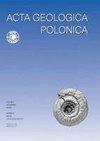Redox conditions, glacio-eustasy, and the status of the Cenomanian–Turonian Anoxic Event: new evidence from the Upper Cretaceous Chalk of England
IF 0.9
4区 地球科学
Q3 GEOLOGY
引用次数: 4
Abstract
The nature of the Cenomanian–Turonian Oceanic Anoxic Event (CTOAE) and its δ13 C Excursion is considered in the light of (1) the stratigraphical framework in which the CTOAE developed in the European shelf seas, (2) conclusions that can be drawn from new detailed investigations of the Chalk succession at three locations in England, at Melton Ross and Flixton in the Northern Province where organic-rich ‘black bands’ are present, and at Dover in the Southern Province (part of the Anglo-Paris Basin) where they are absent, and (3) how these conclusion fit in with the present understanding of the CTOAE. The application of the cerium anomaly method (German and Elderfield 1990) at Dover, Melton Ross and Flixton has allowed the varying palaeoredox conditions in the Chalk Sea and its sediments to be related to the acid insoluble residues, organic carbon, δ18O (calcite), δ13C (calcite), δ13C (organic matter), Fe 2+ and Mn2+ (calcite), and P/TiO2 (acid insoluble residue). This has provided evidence that the initial stages of the δ13C Excursion in England were related to (1) a drop of sea level estimated at between 45 and 85 metres, (2) influxes of terrestrial silicate and organic detritus from adjacent continental sources and the reworking of exposed marine sediments, and (3) the presence of three cold water phases (named the Wood , Jefferies and Black ) associated with the appearance of the cold-water pulse fauna during the Plenus Cold Event. Conditions in the water column and in the chalk sediment were different in the two areas. In the Northern Province, cerium-enriched waters and anoxic conditions were widespread; the δ13C pattern reflects the interplay between the development of anoxia in the water column and the preservation of terrestrial and marine organic matter in the black bands; here the CTOAE was short-lived (~0.25 Ma) lasting only the length of the Upper Cenomanian Metoicoceras geslinianum Zone. In the Southern Province, water conditions were oxic and the δ13C Excursion lasted to the top of the Lower Turonian Watinoceras devonense Zone, much longer (~1.05 Ma) than in the Northern Province. These differences are discussed with respect to (1) the Cenomanian–Turonian Anoxic Event (CTAE) hypothesis when the ocean-continent-atmosphere systems were linked, (2) limitations of chemostratigraphic global correlation, and (3) the Cenomanian–Turonian Anoxic Event Recovery (CTOAER), a new term to define the varying lengths of time it took different oceans and seas to recover once the linked ocean-continent-atmosphere system was over. The possibility is considered that glacio-eustasy (the glacial control hypothesis of Jeans et al. 1991) with the waxing and waning of polar ice sheets, in association with the degassing of large igneous provinces, may have set the scene for the development of the Cenomanian–Turonian Anoxic Event (CTAE).氧化还原条件、冰川-游动和塞诺曼尼亚- turonian缺氧事件的状态:来自英格兰上白垩世白垩世的新证据
Cenomanian-Turonian海洋缺氧事件(CTOAE)及其δ13C漂移的性质是根据(1)CTOAE在欧洲陆架海中形成的地层框架来考虑的,(2)可以从英格兰三个地点的白垩岩序列的新的详细调查中得出的结论,在北部省的Melton Ross和Flixton,那里存在富含有机物的“黑带”,在南部省的Dover(盎格鲁-巴黎盆地的一部分),那里没有,以及(3)这些结论如何与目前对CTOAE的理解相一致。铈异常法(German和Elderfield 1990)在Dover、Melton Ross和Flixton的应用使Chalk海及其沉积物中不同的古氧化还原条件与酸不溶性残留物、有机碳、δ18O(方解石)、δ13C(方解石)和δ13C。这提供了证据,表明英国δ13C漂移的初始阶段与(1)估计海平面下降在45米至85米之间,(2)来自邻近大陆来源的陆地硅酸盐和有机碎屑的流入,以及暴露的海洋沉积物的改造有关,以及(3)三个冷水相(命名为Wood、Jefferies和Black)的存在与Plenus冷事件期间冷水脉冲动物群的出现有关。这两个地区的水柱和白垩沉积物的条件不同。在北方省,富铈水域和缺氧条件普遍存在;δ13C模式反映了水柱缺氧的发展与黑带中陆地和海洋有机物的保存之间的相互作用;这里的CTOAE是短暂的(~0.25 Ma),仅持续上Cenomanian-Metoicoceras-geslinianum带的长度。在南方省,水条件是好的,δ13C漂移持续到下吐隆-屈臣氏泥盆纪带的顶部,比北方省长得多(~1.05Ma)。这些差异是关于(1)当海洋-大陆-大气系统联系在一起时的Cenomanian-Turonian缺氧事件(CTAE)假说,(2)化学地层学全球相关性的局限性,以及(3)Cenomanian–Turonia缺氧事件恢复(CTOAER),这是一个新术语,用来定义一旦相连的海洋-大陆-大气系统结束,不同海洋和海洋恢复所需的不同时间长度。人们认为,冰川海平面上升(Jeans等人的冰川控制假说,1991年)与极地冰盖的增减,以及大型火成岩省的脱气,可能为塞诺曼-土仑缺氧事件(CTAE)的发展奠定了基础。
本文章由计算机程序翻译,如有差异,请以英文原文为准。
求助全文
约1分钟内获得全文
求助全文
来源期刊

Acta Geologica Polonica
地学-地质学
CiteScore
1.70
自引率
18.20%
发文量
0
审稿时长
>12 weeks
期刊介绍:
Acta Geologica Polonica publishes original and review papers on all aspects of basic geology, with particular focus on sedimentology, stratigraphy, palaeontology, regional geology, structural geology, and regional petrography. All papers are published in English.
 求助内容:
求助内容: 应助结果提醒方式:
应助结果提醒方式:


